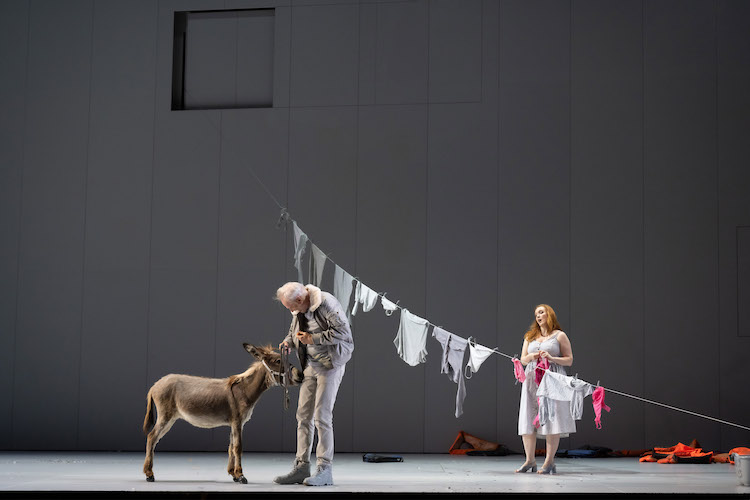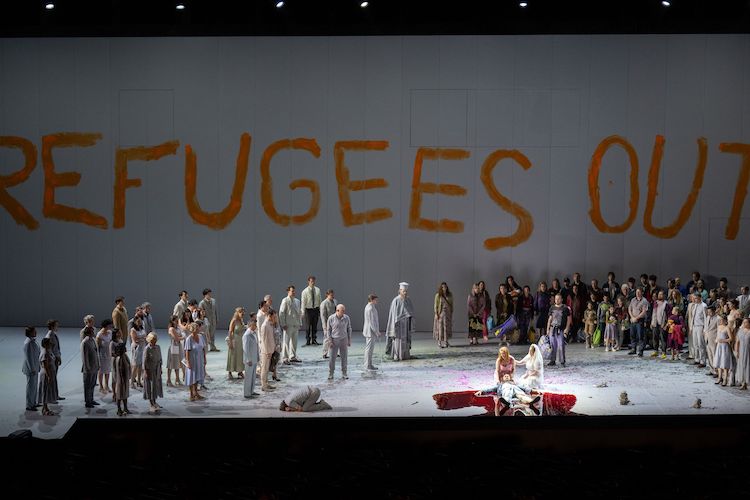Czech composer Bohuslav Martinů was a WWII refugee to the U.S. who returned to Europe (Switzerland) in his last years (d. 1959) where he turned Greek novelist Nikos Kazantzakis’ Christ Recrucified (1948) into an opera (Kazantzakis is the author of Zorba the Greek).
In recent years the Salzburg Festival has embarked on a quest to recognize significant operatic works from the mid years of the 20th century. With the added edge of producing them in the paddock of Salzburg Castle’s old riding school, now a huge platform in front of which sits an orchestra, usually, and in this case as well, the Vienna Philharmonic. It has become the world’s most exciting opera stage.
Just now it has also become one of the world’s most interesting forums for the discussion of the European and American immigrant crises.
If we leave aside the intricacies of sophisticated mid-twentieth century musical style, Martinů’s The Greek Passion is a very simple opera. A band of desperate immigrants arrive in a village, seeking help. They are met with hostility, except by one man and one woman (a Christ figure and a Mary Magdalene figure). The village authority, the priest Grigoris, stokes the villager’s fear of “the other,” insisting that compassion be ignored, that its preachers be stopped. The townsfolk, in turn, crucify the Christ figure.
Entering the Feldenreitschule (the old riding school) there was but the huge, blank stage, the galleries of the riding school completely covered. It was quite unlike all recent Simon Stone productions (Aix, Paris and Salzburg) where there has been a stage of highly detailed architectural realism. This barren, minimalism was the work of British designer Lizzie Clachan. Though it was not barren for long. With the arrival of the multitude of townsfolk (countless choristers) onto the platform bells rang to celebrate Easter, and petals rained down, covering the stage, only to soon be cleaned up, swept into a large square that opened on the floor.
It was not long until the multitude of refugees (countless choristers and children) arrived, unlike the mono-colored townsfolk, they were individually dressed, dragging their colorful survival gear with them. Costuming was designed by frequent Simon Stone collaborator Mel Page, with the intention of abstracting the rigidity of attitude of the townsfolk into a single pale shade, contrasting to the mutable colors of the needs of the refugees. The townsfolk soon threw all these survival possessions into the same square hole in the floor that the petals were swept into.

Of course there were villagers who sympathized with the refugees, not surprisingly those chosen to be the actors of the village’s annual Easter passion play. As well there were philosophical tensions to be resolved. Manolios (Christ) and Katerina (Mary Magdalene) came to grips with their worldly desires. This they did to dramatic scenic effects — a fountain of water fell from the heavens (the theater’s fly loft), jets of steam spewed up through the stage floor). An old villager, Yannakos, came to grips with human greed while leading a real burro across the stage [though the burro refused to leave the stage and had to be pushed off].
It was a compelling, focused, tightly wrought, excellent libretto, made from the Kazantakis novel by the composer himself.
It is exciting music, here conducted by Maxine Pascal of Frances famed contemporary music ensemble Le Balcon, the Vienna Philharmonique conquering Martinů’s constant use of syncopated rhythm with full throated ease. The orchestra was urged to massive climaxes with the choral multitudes through the heroic embodiment of such complexity by the maestro — Mo. Pascal was indeed a significant added visual attraction to what was happening on the stage. [Conducting the highly syncopated music may have required such physical exertions.]
Composer Martinů’s score makes use of many twentieth century musical currents, notably folk music (in his case Czech and Moravian and in this case, Greek). Particularly Martinů admired Stravinsky (also living in the U.S.), American jazz and Aaron Copland — Martinů was very present in the American musical world. There is often pleasing consonance within the Martinů sound though he never shirks from descending into harmonic chaos, pre-spectral in effect.
German tenor Sebastian Kohlhepp performed the role of Manolios, Mr. Kohlhepp well met its Mozartian vocal demands, and enacted both spiritual confusion and spirituality with equal sensitivity. Stage director Simon Stone played upon this sensitivity to stage a very brutal “crucifixion” — a swarm of villagers fell upon him with their knives, though one sprang from the pile, Paneas, who had refused to play Judas in the village’s passion play. He knelt, facing away from the Christ (see photo below).

Manolios was left lying center stage, his blood slowly spreading into a cruciform pool, his head cradled by Katerina, the Mary Magdalene, joined then by his spurned fiancée Lenio [sic], to make a emotionally shattering final tableau. With the Judas figure nearby it achieved genuine, classical pieta status.
There were many interesting and significant voices among the villagers and refugees. Foremost certainly was the Katerina, sung by American soprano Sara Jakubiak who brought strongly voiced strength of tone to the complex psychologies of the Mary Magdalene role. The warm voice and presence of Polish baritone Lukasz Goliński cast as Fotis, priest and leader of the refugees, played heavily on our sympathies. Hungarian bass Gábor Bretz made the anti-refugee case with stern, evangelistic conviction.
German soprano Christina Gnash brought a beautiful, silvery bright voice to Lenio, Manolios’ spurned fiancée, confusing our sympathies. Venerable Arkansas (U.S.) born tenor Charles Workman enacted the character role of Yannakos, humoring his burro with palpable affection.
In 2017 Simon Stone staged the Reimann Lear on this same stage, and in much the same style. The directness of his minimalist style is far more effective/affective than the cinematic realism of his recent opera productions, including the Saariaho Innocence that started at the Aix Festival and is traveling to many of the world’s major stages.
Michael Milenski
Additional casting: Adonis: Matteo Ivan Rasic; Michelis: Matthäus Schmidlechner; Kostandis: Alejandro Balinas Vieites; Panais: Julian Hubbard; Nikolio: Alijoscha Lennert; Eine Frau: Helena Rasker; Patriarcheas: Luke Stoker; Ladas: Robert Dölle; Ein Mann: Scott Wilde; Despinio: Teona Todua; Villagers and Refugees: The concert Choir of the Vienna State Opera with the Children’s Choir of the Salzburg Festival.
Felsenreitschule, Salzburg, August 22, 2023. All The Greek Passion photos copyright Monika Rittershaus, courtesy of the Salzburg Festival.